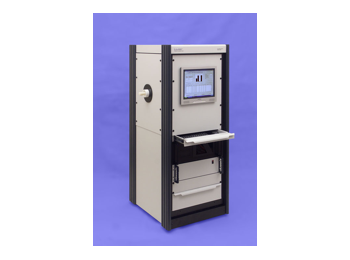
The MMRU is equipped with an EchoMRI-100® QMR instrument that provides precise measurements of total body fat, lean mass, and body water in live mice up to 100 g in weight. The instrument determines the extent to which the protons present in lean and fat tissue perturb a magnetic field. This has been calibrated so that the output can be interpreted in terms of fat and lean masses (see References). The technique is noninvasive, nondestructive, does not require that the animal be sedated and causes no pain or stress.
Measurement Procedure
- Set up the instrument in the lab where you will be doing the measurements. This should include the anesthesia machine if you plan to use isoflurane with a live animal.
- Lightly anesthetize a mouse by placing it in a chamber with isoflurane (5% and 95% oxygen). As soon as the mouse is sedated it is oriented carefully on a disposable PIXImus measuring tray for proper alignment and is fitted with a loosely fitting nose cone for administration of isoflurane (2% isoflurane) until the measurement is complete. If you prefer, you may use an injectable anesthetic.
- The mouse is inserted into the instrument for measurement (approx. 5 minutes) and then returned to a cage to recover under observation. Once fully recovered the mouse can be returned to its home cage.
- Fill out the logbook when you have finished a session. Note that there is a limit in the number of measurements that can be done in a session. This will be explained during training.
There are some systematic errors in the lean and fat mass values obtained by PIXImus that vary depending on the instrument model and software version (see References). To provide more accurate measurements, we have derived some correction equations to apply to the data generated by the CNRC PIXImus. The procedure and further information can be found below
Download calculator for adjusting PIXImus body composition data to chemical analysis-comparable values (Microsoft Excel spreadsheet).
QMR Request and Use Procedures
- The QMR instrument is housed in the MMRU suite (1072) in the CNRF.
- You will need to get IACUC approval for performing the procedure on your animals.
- New users must first go through training on instrument calibration, making measurements, cleaning up, and data access. Training is provided by MMRU staff and is arranged by contacting Dr. Fiorotto, martaf@bcm.edu.
- Once you have been trained, you will be given access to the online QMR calendar so that you can book time on the instrument directly.
- Individuals who book always have priority to drop-ins.
- It is critical that every time you use the instrument you enter the requested information in the instrument log folder.
- The instrument is not connected to the Ethernet, and data should be saved on a USB device.
- Failure to comply with the regulations will result in removal of access privileges
Check QMR or 6-lane Treadmill Availability
Use the QMR or 6-lane treadmill calendar via Outlook calendar for availability and booking:
- In Outlook, click "Folder List" at the bottom left of the Outlook screen.
- Click the > before "Public Folders" then click the > before "All Public Folders."
- Scroll down to "BCM Pediatrics," then inside to "Nutrition."
- Click the Calendar named "QMR or 6-lane treadmill"
- To add to favorites, right-click " QMR or 6-lane treadmill " and then select "Add to Favorites."
- Click "Calendar" (beside "Folder List" at the bottom left of the Outlook screen).
Measurement Procedure
- To perform these measurements the mouse is placed in a Plexiglas tube that is appropriate for its size (6 cm in diameter and restrained to a length of approximately 1-3 cm according to the size of the mouse) and is placed in the instrument's magnetic field.
- The measurements are controlled via a keyboard attached to the instrument computer. Readings are taken over a period of 2 to 4 minutes, after which the mouse is removed and returned to its cage.
- PLEASE NOTE: The presence of ear tags on the mice interferes with the measurements and will produce erroneous data.








